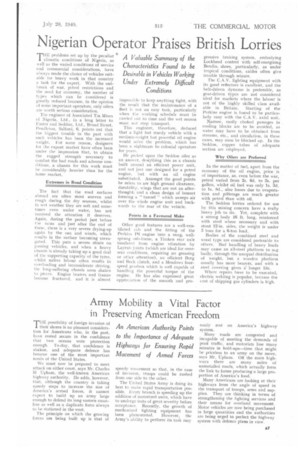Nigerian Operator Praises British Lorries
Page 33

If you've noticed an error in this article please click here to report it so we can fix it.
• A Valuable Summary of the Characteristics Found to be Desirable in Vehicles Working Under Extremely Difficult
Conditions
THE problems set up by the peculiar climatic conditions of Nigeria, as well as the varied conditions of service and commercial considerations, have always made the choice of vehicles suitable for heavy work in that country a task for the expert. With the outbreak of war, petrol restrictions and the need for economy, the number of types which can be considered is greatly reduced because, in the opinion of sonic important operators, only oilers are worth serious consideration.
The engineer of Associated Tin Mines of Nigeria, Ltd., in a long letter to Foster and Seddon, Ltd., Broad Street, Pendleton, Salford, 6, points out that the biggest trouble in the past with such vehicles has been the increased weight. For some reason, designers for the export market have often been under the impression that, to obtain the rugged strength necessary to combat the bad roads and adverse conditions, a chassis for this work must be considerably heavier than for the home market.
Extremes in Road Condition
The fact that the road surfaces abroad are often most uneven and rough during. the dry seasons, whilst in wet weather they are soft and sometimes even under water, has not received the attention it deserves. Again, during the period just before the rains and just after the end of these, there is a very severe drying-up again by the sun and winds, which results in the surface becoming corrugated. This puts a severe strain on passing vehicles, and when a heavy chassis is already taking up a good deal of the supporting capacity of the tyres, whilst native labour often results in overloading and inconsiderate driving, the long-suffering chassis soon shakes to pieces. Engine bearers and frames become fractured, and it is almost
impossible to keep anything tight, with the result that the maintenance of a fleet is not an easy task, particularly when the working schedule must be carried out to time and the wet season must not stop transport.
This engineer, therefore, deduced that a light but sturdy vehicle with a medium-weight but powerful oil engine would solve the problem, which has been a nightmare to colonial operators for years.
He picked upon the Seddon oiler as an answer, describing this as a chassis built around an efficient power .unit, and not just one designed for a petrol engine, but with an oil engine substituted. Amongst the good points he refers to are high ground clearance, durability, wings that are not an afterthought, and a clean design of bonnet forming a " tunnel " which sweeps air over the whole engine unit and backwards to the rear of the vehicle, Points in a Favoured Make
Other good features are a well-ventilated cab and the fitting of the Perkins P6 engine into a snug, wellsprung sub-frame, a Timken rear axle insulated from engine vibration by Layrub joints (which are ideal for overseas conditions, requiring no greasing or other attention), an efficient Borg and Beck clutch, and a Meadows fourspeed gearbox which is well capable of handling the powerful torque of the engine. lie has also expressed great appreciation of the smooth and pro
gressive braking system, embodying Lockheed control with self-energizing Benclix, shoes, particularly, as under tropical conditions, cables often give trouble through seizure.
The C.A.V. lighting equipment with its good reflectors is excellent, and the belt-driven dynamo is preferable, as gear-driven types are not considered ideal for markets where the labour is not of the highly skilled class available in Britain. Starting of the Perkins engine is found to be particularly easy with the C.A.V. axial unit.
Narrow, easily choked passages in . cooling blocks are to be avoided, as water may have to be obtained from streams, etc., and circulation, in these cases, may soon be blocked up. In the Seddon, copper tubes of adequate section are employed.
Why Oilers are Preferred In the matter of fuel, apart from the economy of the oil engine, price • is of importance, as, even before the war, petrol varied from 2s. 6d. to 3s. per gallon, whilst oil fuel was only is. 3d. to is. Sd., also losses due to evaporation and pilferage are much greater with petrol than with oil, The Seddon lorries ordered for use by this mining concern have a really heavy job to do. Yet, complete with a strong body 16 ft. long, reinforced with steel where necessary and with stout 12-in, sides, the weight is under 3 tons for a 6-ton load.
Bodies of the combined steel and wood type are considered preferable to others. Had handling of heavy loads may cause an all-steel platform to sag badly, through the unequal distribution of weight, but a wooden platform usually has more bearers, and with a steel covering gives a' longer life.
Where repairs have to be executed, electric welding is popular, because the cost of shipping gas cylinders is high.




























































